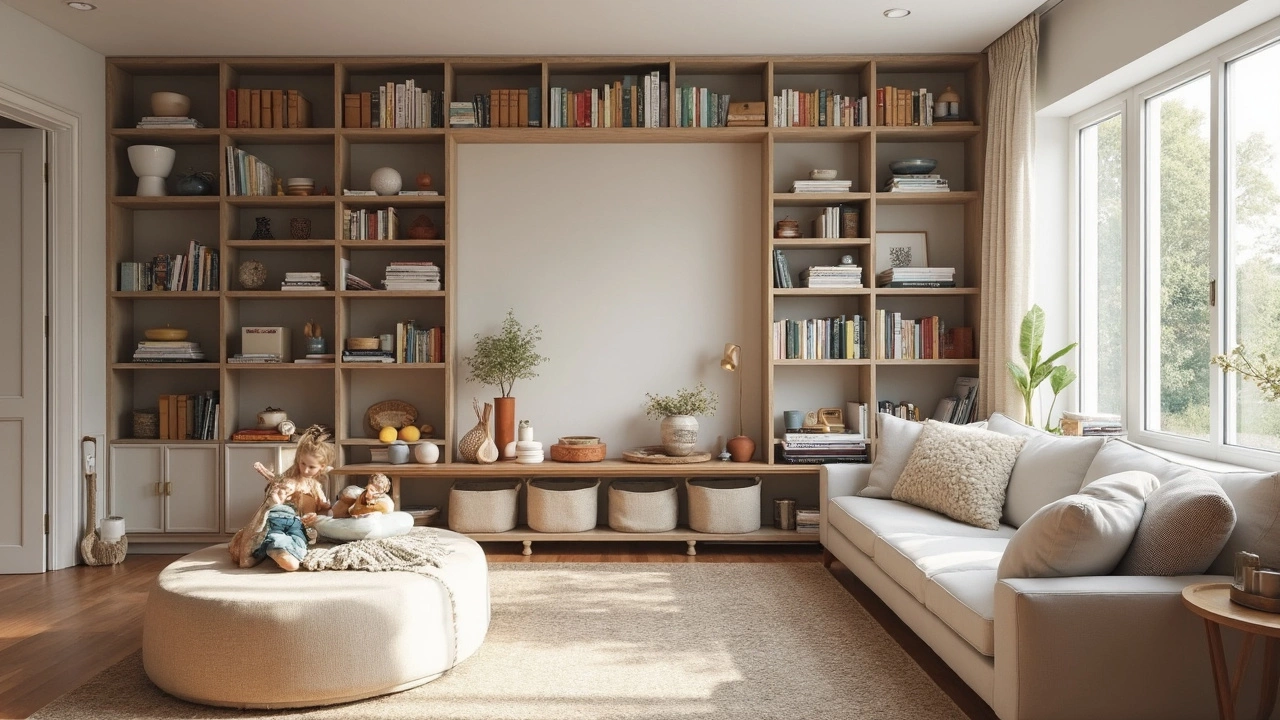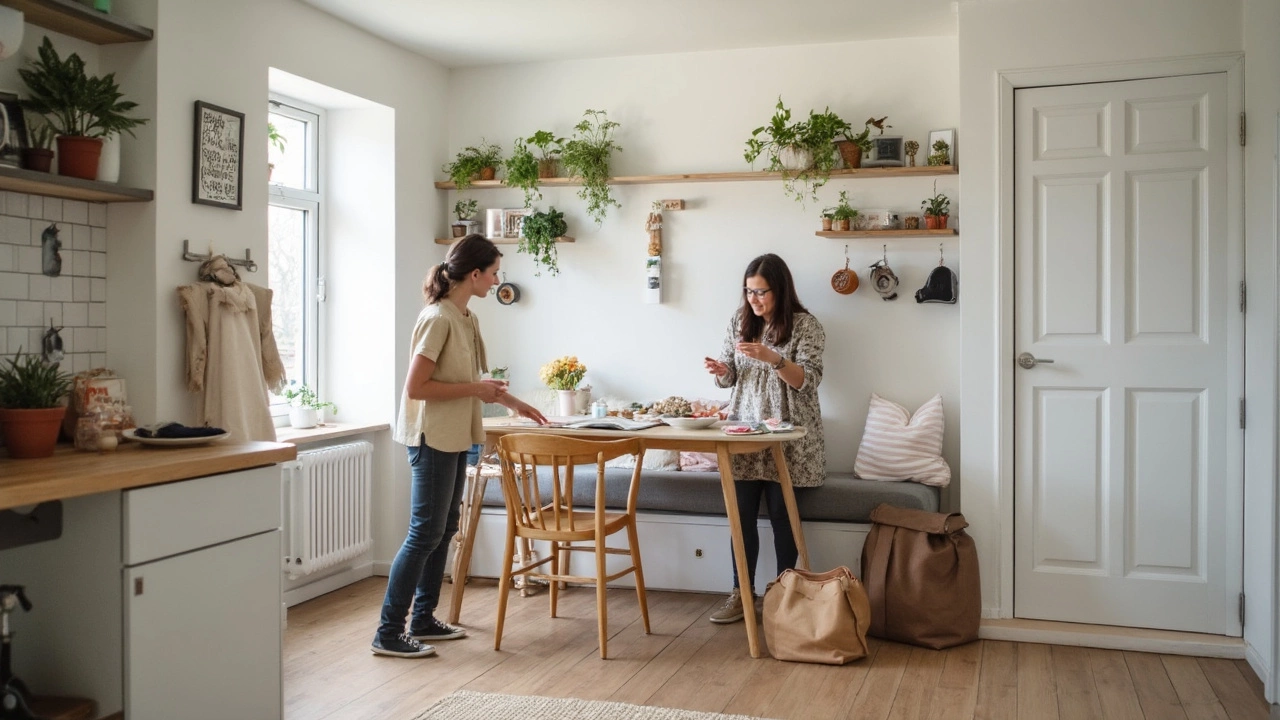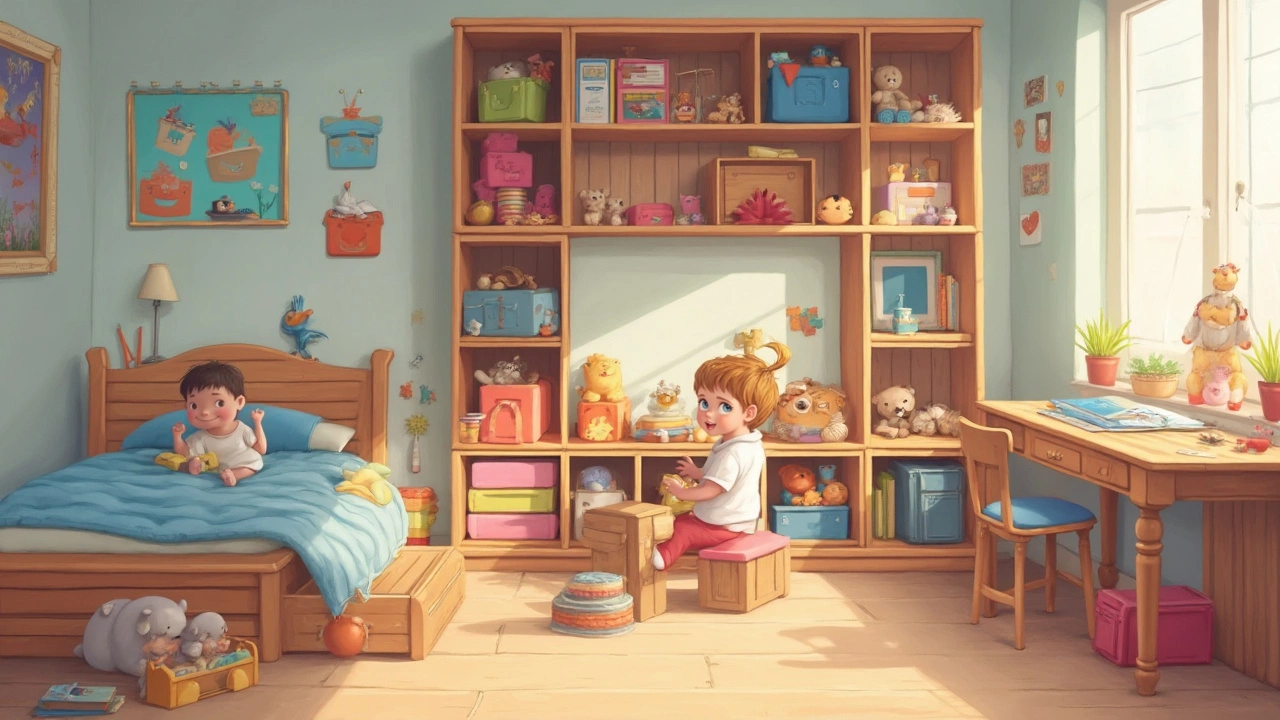How to Create Extra Storage in a House: Simple Storage Solutions That Work
 Apr, 30 2025
Apr, 30 2025
Sick of hunting for more closet space or wrestling with that junk drawer? Most homes have loads of hidden spots just begging to be used for storage—you just have to know where to look. Think under the stairs, above cabinets, or even inside walls. People often forget about the space under their beds, which can swallow up shoes, winter clothes, and random stuff that doesn’t have a home.
One quick win: get storage bins that actually fit the space you have, like slim ones for under the bed or stackable crates for that weird spot in the garage. If your closets are stuffed, add a second hanging rod or use thin vertical shelves to double what you can stash. The biggest mistake? Thinking you need to buy expensive organizers before figuring out what space is really available. Start by spotting every unused inch, and you’ll get way more out of the rooms you already have.
- Hidden Storage Spots You’re Probably Missing
- Using Furniture to Double Up on Space
- Smart Wall and Ceiling Solutions
- Decluttering Tricks that Free Up Space
- Organizing for Long-Term Success
Hidden Storage Spots You’re Probably Missing
When you think of extra storage, your mind jumps to closets and bins. But the truth is, most homes have totally overlooked zones just waiting for you. One of the sneakiest? The gap over your doors. Standard homes in the US lose about 12-18 inches of space above every doorway. Install a shelf up there and you’ve got quick access for books, baskets, or even rarely-used kitchen stuff.
Ever notice the dead space under your stairs? That’s prime real estate for storage solutions. People build slide-out drawers or even tiny closets in that odd triangular spot. If you’re not up for DIY, just tuck storage containers or shoe cubbies underneath—no tools needed.
Old-school radiators or window seats? Those often have empty bases. Lift the lid or add hinges and suddenly there’s room for winter blankets or board games. The tops of kitchen cabinets are another goldmine. Even if you hate dusting, stick items in covered bins and stack them high—it’s out of sight but easy to reach.
- Behind doors: Hang racks or slim baskets for shoes, cleaning gear, or snack packs.
- Kickplates under cabinets: Some folks add drawers under the lowest kitchen cabinets; it’s a clever spot for baking sheets or extra towels.
- Ceiling corners: In the garage or laundry room, build small loft shelves for bulky stuff you rarely need.
You might be surprised, but a 2022 survey found that 65% of homeowners never use these hidden nooks. Tapping into these spaces gives you more home organization options without adding new furniture or knocking down walls.
Using Furniture to Double Up on Space
When you start looking at your stuff through the lens of storage solutions, all kinds of furniture suddenly pull double-duty. Think about ottomans that open up like secret chests, beds with drawers underneath, or coffee tables that stash board games or remotes right inside. You don’t have to give up comfort or style—plenty of brands even pitch entire lines of multi-use furniture because it’s just that practical.
TV stands and sideboards aren’t just for electronics. Load them up with photo albums, craft supplies, or that bundle of charging cords you never want to see again. Some folks are even swapping out old-school couches for ones with built-in cubbies or under-seat rollers. The best part? Nobody can tell you’re hiding half your stuff just below the surface.
- Storage benches: Put one in the entryway for shoes and winter hats, or at the foot of the bed for extra blankets.
- Lift-top coffee tables: These are killer for living rooms that need to multitask, holding puzzles, snacks, or even paperwork if you work from home.
- Beds with built-in drawers: Forget that wasted space—store holiday gear, extra bedding, or off-season clothes without even thinking about it.
- Wall-mounted desks: Fold them out for work, then stash your supplies on shelves or inside hidden cubbies.
- Convertible sofas or futons: Not just for unexpected guests—use the hidden space inside for linens or kid gear.
Here’s something wild: a 2023 survey by the National Association of Home Builders found that 63% of buyers now look for houses with built-in storage furniture. People don’t just want nice sofas—they want those sofas to pull their weight when it comes to staying tidy!
None of this means you have to gut your house or drop thousands on new furniture. Sometimes it’s just about rethinking what you already own, like slipping shallow baskets under chairs or grabbing a tray for the shelf under your coffee table. Each piece that does more than just “sit there” makes life with less clutter a whole lot easier—and your home organization game way stronger.

Smart Wall and Ceiling Solutions
If your floor space is packed and closets are busting at the seams, look up and around. Most homes waste loads of wall and ceiling space that could turn into actual storage solutions. Pegboards, floating shelves, and wall-mounted baskets make it way easier to free up corners and counters. Got a garage, laundry, or tiny kitchen? Vertical storage almost always gives you more options for organizing stuff that never seems to fit anywhere else.
Stick a sturdy pegboard on an empty wall and suddenly you have a spot for tools, kitchen gear, or even craft supplies. You can move hooks and baskets around whenever you need, which is great if you’re always switching things up. Floating shelves don’t have to be fancy or expensive—basic ones from any home store hold books, shoes, cleaning supplies, or even pots and pans if you’re out of cupboard space. Try running two or three shelves all the way up to the ceiling to actually use every bit of vertical space you have.
Ceiling racks are a secret weapon in garages and small laundry rooms. Store bikes, camping gear, or out-of-season decorations way up high and you’ll clear out ground-level mess fast. Just double check the installation: most ceiling racks are rated for 250 to 400 pounds, but you need to find the studs and follow the weight limits. Don’t risk a big crash!
- Install S-hooks under kitchen shelves to hang mugs and utensils.
- Mount baskets or racks inside closet doors for shoes or cleaning products.
- Add magnetic strips for knives or tools on the wall by your workbench or kitchen counter.
- Try a fold-down wall desk if you need a workspace but zero floor area.
Here’s some real data: according to a 2023 survey by Houzz, nearly 68% of homeowners who upgraded kitchen storage used wall-mounted solutions like shelves or racks. Less clutter, more room to cook—it’s a win all around.
| Storage Type | Average Weight Capacity | Best For |
|---|---|---|
| Floating Shelf | 30-50 lbs | Books, decor, small kitchenware |
| Ceiling Rack | 250-400 lbs | Bikes, bins, seasonal gear |
| Pegboard | Varies (check product) | Tools, kitchen items, arts and crafts |
The trick is to use your walls and ceilings with the same intensity as your floors and closets. When you think vertical, you’ll find a home for almost anything—and your house will look way neater, too.
Decluttering Tricks that Free Up Space
Tired of wasting time looking for stuff you never use? You’re not alone. Most folks hold onto way more than they need, and that’s where decluttering comes in. Here’s the deal: once you clear out the excess, you free up those valuable storage solutions for stuff that actually matters—no more doubling up on things you thought you’d lost.
Start with one spot at a time. Trying to declutter the whole house at once can make you want to quit. The most productive way? Pick a small area—like a single kitchen drawer, your hallway closet, or a bathroom shelf—so you can see progress right away.
- The 12-12-12 Challenge: Grab a box and find 12 items to throw out, 12 to donate, and 12 to put back in the right spot. Simple, fast, and it gets results.
- One-In, One-Out Rule: For every new thing you bring home, let one go. It’s the easiest way to keep clutter from creeping back in.
- The Six-Month Test: Haven’t used it in half a year? Odds are, you won’t miss it. Bag it up, and if you’re really worried, label it with today’s date. If you don’t need it in six more months, donate or trash it without a second thought.
- Group Similar Stuff: Piling similar things together makes it easier to spot doubles. Turns out, a lot of those “just in case” extras never see daylight again.
Here’s a reality check—according to a 2023 national survey, nearly 60% of people say clutter at home adds daily stress. And American homes, on average, have over 300,000 items. That’s a mountain of stuff to manage, and it’s no wonder home organization feels impossible sometimes.
| Decluttered Space | Average Items Removed |
|---|---|
| Bedroom closet | 35 |
| Kitchen cabinets | 24 |
| Garage | 57 |
After the initial cleanout, set a reminder to do a quick once-over every season. Spring or fall are good times to catch things before they pile up again. Once you get serious about declutter, you’ll be shocked how quickly your house feels lighter and your extra storage options multiply.

Organizing for Long-Term Success
You finally created extra storage, but if you want it to stay useful, you’ve got to keep things in order for the long haul. The trick? Don’t treat organizing like a one-time job. Stuff piles up fast if you don’t build a routine around it. Start by labeling bins, drawers, and shelves. It sounds simple, but labeling cuts down on confusion—and helps everyone in the house know where things go (and where to put them back).
Set a reminder to do a quick declutter every three months. You’d be shocked how much old paperwork, mismatched socks, and even broken chargers sneak back in. Experts say the average home stores around 300,000 items. Yeah, you read that right. Doing a seasonal sweep helps you stay on top of the clutter before it gets out of hand.
A good strategy is to make use of the “one-in, one-out” rule. For every new item you bring into your home—whether it’s a shirt, toy, or kitchen gadget—move out something you no longer use. It’s a simple way to keep your home organization in check with zero spreadsheets required.
- Keep a donation box handy in a closet or laundry room. When you come across something you don’t use, just toss it in.
- If you share your home, get everyone on board with monthly family “reset” sessions. Just 15 minutes can make a big difference.
- Back up important papers digitally so you don’t have to keep all that physical stuff lying around.
- Use clear bins for high-traffic areas—if you can see what’s inside, you’re much less likely to let it turn into a chaos zone.
Don’t forget small victories—set up a spot for daily drop zones, like keys or mail, so clutter doesn’t stack up where you can’t find it. With regular habits and a few smart tricks, your storage solutions actually stay organized instead of turning back into a mess. Nobody’s perfect, but a little upkeep now beats a closet avalanche later.